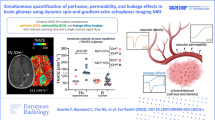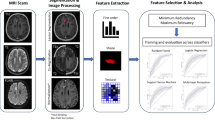Abstract
Purpose
Superselective intra-arterial cerebral infusion (SIACI) of bevacizumab (BV) has emerged as a novel therapy in the treatment of recurrent glioblastoma (GB). This study assessed the use of apparent diffusion coefficient (ADC) in predicting length of survival after SIACI BV and overall survival in patients with recurrent GB.
Methods
Sixty-five patients from a cohort enrolled in a phase I/II trial of SIACI BV for treatment of recurrent GB were retrospectively included in this analysis. MR imaging with a diffusion-weighted (DWI) sequence was performed before and after treatment. ROIs were manually delineated on ADC maps corresponding to the enhancing and non-enhancing portions of the tumor. Cox and logistic regression analyses were performed to determine which ADC values best predicted survival.
Results
The change in minimum ADC in the enhancing portion of the tumor after SIACI BV therapy was associated with an increased risk of death (hazard ratio = 2.0, 95% confidence interval(CI) [1.04–3.79], p = 0.038), adjusting for age, tumor size, BV dose, and prior IV BV treatments. Similarly, the change in ADC after SIACI BV therapy was associated with greater likelihood of surviving less than 1 year after therapy (odds ratio = 7.0, 95% CI [1.08–45.7], p = 0.04). Having previously received IV BV was associated with increased risk of death (OR 18, 95% CI [1.8–180.0], p = 0.014).
Conclusion
In patients with recurrent GB treated with SIACI BV, the change in ADC value after treatment is predictive of overall survival.


Similar content being viewed by others
References
Stupp R, Hegi ME, Mason WP et al (2009) Effects of radiotherapy with concomitant and adjuvant temozolomide versus radiotherapy alone on survival in glioblastoma in a randomised phase III study: 5-year analysis of the EORTCNCIC trial. Lancet Oncol 10:459–466
Wong ET, Hess KR, Gleason MJ et al (1999) Outcomes and prognostic factors in recurrent glioma patients enrolled onto phase II clinical trials. J Clin Oncol 17:2572–2578
Dvorak HF (2002) Vascular permeability factor/vascular endothelial growth factor: a critical cytokine in tumor angiogenesis and a potential target for diagnosis and therapy. J Clin Oncol 20(21):4368–4380
O’Connor JPB, Carano RAD, Clamp AR et al (2009) Quantifying antivascular effects of monoclonal antibodies to vascular endothelial growth factor: insights from imaging. Clin Cancer Res 15(21):6674–6682
Zagzag D, Lukyanov Y, Lan L et al (2006) Hypoxia-inducible factor 1 and VEGF upregulate CXCR4 in glioblastoma: implications for angiogenesis. Lab Investig 86(12):1221–1232
Boockvar JA, Tsiouris AJ, Hofstetter CP et al (2011a) Safety and maximum tolerated dose of superselective intraarterial cerebral infusion of bevacizumab after osmotic blood-brain barrier disruption for recurrent malignant glioma. J Neurosurg 114:624–632
Riina HA, Fraser JF, Fralin S et al (2009a) Superselective intraarterial cerebral infusion of bevacizumab: a revival of interventional neuro-oncology for malignant glioma. J Exp Ther Oncol 8:145–150
Burkhardt J-K, Riina HA, Shin BJ et al (2012a) Intra-arterial delivery of bevacizumab after blood brain barrier disruption for the treatment of recurrent glioblastoma: progression free survival and overall survival. World Neurosurg 77:130–134
Fischer I, Cunliffe CH, Bollo RJ et al (2008) High-grade glioma before and after treatment with radiation and Avastin: initial observations. J Neuro-Oncol 10:700–708
Pope WB, Lai A, Nghiemphu P et al (2006) MRI in patients with high-grade gliomas treated with bevacizumab and chemotherapy. Neurology 66:1258–1260
Wagle N, Nghiemphu L, Lai A et al (2010) Update and developments in the treatment of glioblastoma multiforme—focus on bevacizumab. Pharmacogenomics Pers Med 3:79–85
Wen PY, MacDonald DR, Reardon DA et al (2010) Updated response assessment criteria for high-grade gliomas: Response Assessment in Neuro-Oncology Working Group. J Clin Oncol 28:1963–1972
Hygino da Cruz LC Jr, Rodriguez I, Domingues RC et al (2011) Pseudoprogression and pseudoreponse: imaging challenges in the assessment of posttreatment glioma. Am J Neuroradiol 32:1278–1285
Higano S, Yun X, Kumabe T et al (2006) Malignant astrocytic tumors: clinical importance of apparent diffusion coefficient in prediction of grade and prognosis. Radiology 241:839–846
Keunen O, Johansson M, Oudin A et al (2011) Anti-VEGF treatment reduces blood supply and increases tumor cell invasion in glioblastoma. PNAS 108:3749–3754
Mong S, Ellingson BM, Nghiemphu PL et al (2012) Persistent diffusion restricted lesions in bevacizumab-treated malignant gliomas are associated with improved survival compared with matched controls. Am J Neuroradiol 33(9):1763–1770
Mardor Y, Roth Y, Ochershvilli A et al (2004) Pretreatment prediction of brain tumors’ response to radiation therapy using high b-value diffusion-weighted MRI. Neoplasia 6:136–142
Chenevert TL, Sundgren PC, Ross BD (2006) Diffusion imaging: insight to cell status and cytoarchitecture. Neuroimaging Clin N Am 16:619–632 viii-ix
Riina HA, Fraser JF, Fralin S et al (2009b) Superselective intraarterial cerebral infusion of bevacizumab: a revival of interventional neuro-oncology for malignant glioma. J Exp Ther Oncol 8:145–150
Boockvar JA, Tsiouris AJ, Hofstetter CP et al (2011b) Safety and maximum tolerated dose of superselective intraarterial cerebral infusion of bevacizumab after osmotic blood-brain barrier disruption for recurrent malignant glioma. Clinical article J Neurosurg 114:624–632
Burkhardt JK, Riina H, Shin BJ et al (2012b) Intra-arterial delivery of bevacizumab after blood-brain barrier disruption for the treatment of recurrent glioblastoma: progression-free survival and overall survival. World neurosurgery 77:130–134
Jeon JY, Kovanlikaya I, Boockvar JA et al (2012) Metabolic response of glioblastoma to superselective intra-arterial cerebral infusion of BV: a proton MR spectroscopic imaging study. AJNR Am J Neuroradiol 33:2095–2102
Wetzel SG, Cha S, Johnson G, Lee P et al (2002) Relative cerebral blood volume measurements in intracranial mass lesions: interobserver and intraobserver reproducibility study. Radiology 224(3):797–803
Yamasaki F, Sugiyama K, Ohtaki M et al (2010) Glioblastoma treated with postoperative radio-chemotherapy: prognostic value of apparent diffusion coefficient at MR imaging. Eur J Radiol 73(3):532–537
Landis JR, Koch GG (1977) The measurement of observer agreement for categorical data. Biometrics 33(1):159–174
Chinot OL, Wick W, Mason W et al (2014) Bevacizumab plus radiotherapy-temozolomide for newly diagnosed glioblastoma. N Engl J Med 370(8):709–722
Balmaceda C, Critchell D, Mao X et al (2006) Multisection 1H magnetic resonance spectroscopic imaging assessment of glioma response to chemotherapy. J Neuro-Oncol 76:185–191
Smith EA, Carlos RC, Junck LR et al (2009) Developing a clinical decision model:MR spectroscopy to differentiate between recurrent tumor and radiation change. Am J Roentgenol 192:W45–W52
Weybright P, Sundgren PC, Maly P et al (2005) Differentiation between brain tumor recurrence and radiation injury using MR spectroscopy. AJR Am J Roentgenol 185:1471–1476
Srinivasan R, Phillips JJ, VandenBerg SR et al (2010) Ex vivo MR spectroscopic measure differentiates tumor from treatment effects in GBM. Neurooncology 12:1152–1161
Singh R, Kesavabhotla K, Kishore SA et al (2016) Dynamic susceptibility contrast-enhanced MR perfusion imaging in assessing recurrent glioblastoma response to susperselective intra-arterial bevacizumab therapy. AJNR Am J Neuroradiol 37:1838–1843
Paldino MJ, Desjardins A, Friedman HS et al (2012) A change in the apparent diffusion coefficient after treatment with bevacizumab is associated with decreased survival in patients with recurrent glioblastoma multiforme. Br J Radiol 85:382–389
Zhang M, Gulotta B, Thomas A et al (2016) Large-volume low apparent diffusion coefficient lesions predict poor survival in bevacizumab-treated glioblastoma patients. Neuro-Oncology 18(5):735–743
LaViolette PS, Mickevicius NJ, Cochran EJ et al (2014) Precise ex vivo histological validation of heightened cellularity and diffusion-restricted necrosis in regions of dark apparent diffusion coefficient in 7 cases of high-grade glioma. Neuro-Oncology 16(12):1599–1606
Ellingson BM, Kim E, Woodworth DC et al (2015) Diffusion MRI quality control and functional diffusion map results in ACRIN 6677/RTOG 0625: a multicenter, randomized, phase II trial of bevacizumab and chemotherapy in recurrent glioblastoma. Int J Oncol 46(5):1883–1892
Nguyen HS, Milbach N, Hurrell SL et al (2016) Progressing bevacizumab-induced diffusion restriction is associated with coagulative necrosis surrounded by viable tumor and decreased overall survival in patients with recurrent glioblastoma. Am J Neuroradiol 37:2201–2208
Ellingson BM, Sahebjam S, Kim HJ et al (2014) Pretreatment ADC histogram analysis is a predictive imaging biomarker for bevacizumab treatment but not chemotherapy in recurrent glioblastoma. AJNR Am J Neuroradiol 35(4):673–679
Pope WB, Qiao XJ, Kim HJ et al (2012) Apparent diffusion coefficient histogram analysis stratifies progression-free and overall survival in patients with recurrent GBM treated with bevacizumab: a multi-center study. J Neuro-Oncol 108:491–498
Lu KV, Bergers G (2013) Mechanisms of evasive resistance to anti-VEGF therapy in glioblastoma. CNS Oncol 2(1):49
Author information
Authors and Affiliations
Corresponding author
Ethics declarations
Funding
This study was funded by the National Cancer Institute grant CA130985.
Conflict of interest
The authors declare that they have no conflict of interest.
Ethical approval
All procedures performed in this retrospective study involving human participants were in accordance with the ethical standards of the institutional and/or national research committee and with the 1964 Helsinki Declaration and its later amendments or comparable ethical standards.
Informed consent
Informed consent was obtained from all individual participants included in the study.
Rights and permissions
About this article
Cite this article
Galla, N., Chiang, G., Chakraborty, S. et al. Apparent diffusion coefficient changes predict survival after intra-arterial bevacizumab treatment in recurrent glioblastoma. Neuroradiology 59, 499–505 (2017). https://doi.org/10.1007/s00234-017-1820-4
Received:
Accepted:
Published:
Issue Date:
DOI: https://doi.org/10.1007/s00234-017-1820-4




